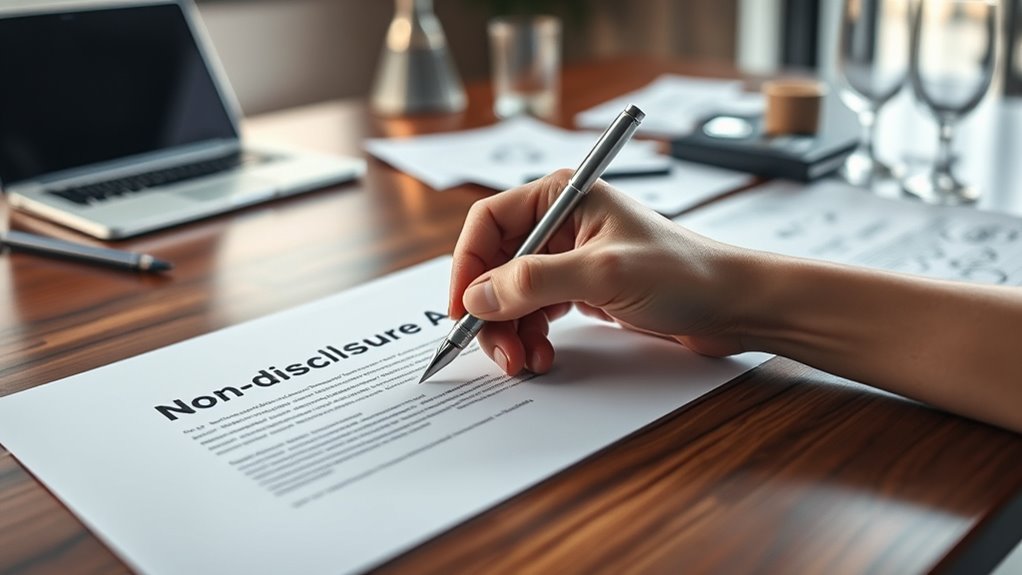A non-disclosure agreement (NDA) helps protect your design concepts by clearly defining what information must stay confidential. It sets legal boundaries to prevent unauthorized use, copying, or sharing of your ideas, safeguarding your intellectual property. NDAs also build trust between parties and provide legal recourse if someone breaches the agreement. With a well-crafted NDA, your innovative ideas stay secure, allowing you to focus on development—continue to discover how these agreements can best serve your needs.
Key Takeaways
- NDAs clearly define and restrict the sharing of sensitive design concepts to prevent unauthorized disclosure.
- They legally safeguard intellectual property from theft or replication during collaborations.
- NDAs specify the duration and scope of confidentiality, ensuring long-term protection of designs.
- They establish trust between parties, enabling secure sharing of innovative ideas.
- Well-crafted NDAs provide legal recourse if confidentiality breaches occur.

Have you ever wondered how companies protect their sensitive information? It’s an essential concern, especially when it comes to safeguarding your innovative ideas and unique designs. Non-disclosure agreements (NDAs) serve as a critical tool in this process. At the heart of many NDAs are confidentiality clauses, which clearly define what information must remain private. These clauses specify the scope of confidential data, including design concepts, technical specifications, and proprietary processes. By establishing clear boundaries, confidentiality clauses ensure everyone understands what information cannot be shared or disclosed without permission.
When you’re sharing your design concepts with potential partners, manufacturers, or investors, you want to be confident that your intellectual property remains protected. NDAs are designed precisely for this purpose. They act as legal barriers, preventing others from copying, distributing, or using your ideas without authorization. This protection is indispensable because, once your ideas are out in the open without safeguards, they can be easily replicated or stolen. An NDA formalizes your expectations and creates a legal obligation for others to keep your intellectual property confidential.
In addition to confidentiality clauses, NDAs often include clauses that address the handling and return of sensitive materials, as well as the duration of confidentiality obligations. This ensures that your design concepts are protected not just during the partnership or project but also after it ends. You’ll want to specify how long the confidentiality must be maintained, especially if your designs are groundbreaking and could be copied years later. These provisions give you peace of mind, knowing that your intellectual property is safeguarded over time.
It’s also important to recognize that NDAs aren’t just about stopping leaks; they’re about establishing trust. When you ask someone to sign an NDA, you’re signaling that your ideas are valuable and deserve respect. This helps build a professional relationship where both parties understand the importance of confidentiality. Plus, having a signed agreement provides you with legal recourse if someone breaches the terms, giving you leverage to protect your designs if someone tries to misuse your intellectual property.
Ultimately, using NDAs with well-crafted confidentiality clauses is an intelligent move for anyone involved in design or innovation. They help preserve the uniqueness of your concepts, prevent unauthorized use, and reinforce your rights over your intellectual property. With proper legal safeguards in place, you can focus on developing your ideas without constantly worrying about theft or misuse, knowing that your confidential information is protected by a solid agreement. Additionally, understanding how to protect your intellectual property is crucial when sharing innovative ideas in any environment.
Frequently Asked Questions
How Long Does a Typical NDA Remain in Effect?
A typical NDA remains in effect for a duration validity that usually ranges from 1 to 5 years, depending on the agreement’s terms. The enforcement timeline varies, but it generally lasts as long as the confidentiality obligations are in place, often extending beyond the project’s end. You should review your NDA carefully to understand its specific duration and enforceability, ensuring your design concepts stay protected throughout that period.
Can NDAS Be Challenged or Invalidated Legally?
In the age of digital dragons, you might wonder if NDAs can be challenged or invalidated. Yes, they can face legal challenges if they’re poorly drafted or contain validity issues. Courts may invalidate an NDA if it’s unreasonable or violates public policy. To protect your design concepts, guarantee your NDA is clear, fair, and enforceable, reducing the risk of it being challenged or deemed invalid later on.
Are Verbal NDAS as Enforceable as Written Ones?
Verbal NDAs aren’t as enforceable as written ones because written agreements provide clear, tangible proof of the commitments made. While verbal agreements can be legally binding, proving their terms in court is often difficult, making their enforceability less reliable. To protect your design concepts effectively, it’s best to have a written NDA, ensuring clarity and stronger legal enforceability if disputes arise.
What Are the Penalties for Breaching an NDA?
Back in the day, breaching an NDA could land you in hot water. If you violate the agreement, you face liability risks, including legal action and damages. Penalties often involve monetary damages, injunctions, or even termination of contracts. Confidentiality clauses are enforceable, and breaching them can severely harm your reputation. To avoid these penalties, always honor your NDA commitments and understand the specific terms and consequences outlined in the agreement.
Can NDAS Be Customized for Specific Industries or Projects?
Yes, you can customize NDAs for your industry or project. Industry-specific clauses address particular needs, such as confidentiality in tech or healthcare, ensuring relevant protections. Project customization allows you to tailor terms to your unique circumstances, like duration or scope of confidentiality. This flexibility helps you better safeguard your design concepts and proprietary information, making the NDA more effective and aligned with your specific requirements.
Conclusion
By signing a non-disclosure agreement, you’re planting a sturdy shield around your creative ideas, like a protective canopy sheltering delicate blooms from the storm. Think of it as locking your design’s secrets behind unbreakable doors, ensuring that your vision remains yours alone. With this safeguard in place, you can confidently share your concepts, knowing your innovative sparks won’t fade into the shadows or fall into the wrong hands. Protect your masterpiece and let your ideas flourish freely.









